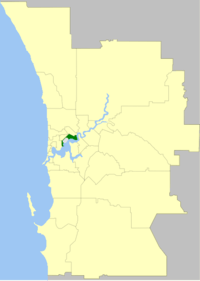City of Perth
| City of Perth Western Australia | |||||||||||||
|---|---|---|---|---|---|---|---|---|---|---|---|---|---|
 | |||||||||||||
| Population | 21,092 (2015 est)[1] | ||||||||||||
| • Density | 881.40/km2 (2,282.8/sq mi) | ||||||||||||
| Established | 1856 | ||||||||||||
| Area | 23.93 km2 (9.2 sq mi)[2] | ||||||||||||
| Mayor | Lisa Scaffidi | ||||||||||||
| Council seat | Perth | ||||||||||||
| Region | Central Perth | ||||||||||||
| State electorate(s) | Perth | ||||||||||||
| Federal Division(s) | Perth | ||||||||||||
 | |||||||||||||
| Website | City of Perth | ||||||||||||
| |||||||||||||
The City of Perth is a local government area and body, within the Perth metropolitan area, which is the capital of Western Australia. The local government is commonly known as Perth City Council. The City covers the Perth city centre and surrounding suburbs. The City covers an area of 8.12 square kilometres (3 sq mi) and had an estimated population of 21,092 as at 30 June 2015. On 1 July 2016 the City expanded, absorbing 1,247 residents from the City of Subiaco.
History

In 1694, the Dutch ship Ridderschap van Hollant was lost off the Western Australian coast near Perth.[3]
In 1829, Captain James Stirling founded Perth as part of the Swan River Colony. The City of Perth was officially declared on 20 September 1856.[4]
In 1915, it absorbed North Perth (1901) and Leederville (1895) municipalities, and on 1 November 1917, Victoria Park was also absorbed. A year later, it absorbed territory from Perth Road Board including the Belmont Park racecourse.
By 1962, the council had 27 members representing nine wards.[5]
On 1 July 1994, following the passage of the City of Perth Restructuring Act (1993), the City of Perth was broken up and a significantly reduced City of Perth reconsistutued. The Town of Victoria Park, Town of Cambridge and Town of Vincent were created from the former boundaries of the City.[6] The first elections were held on 6 May 1995, with 8 councillors and a mayor.
The City of Perth Act 2016 defined Perth as the capital of Western Australia,[7] and expanded the City's boundaries to include a number of landmarks including Kings Park, University of Western Australia, Perth Children's Hospital and the Queen Elizabeth II Medical Centre. The boundary changes took effect on 1 July 2016.[8] Approximately 1,247 residents from Nedlands and Subiaco in the City of Subiaco were transferred to the City of Perth, and the City expanded to a total area of 26.93 square kilometres (10 sq mi).[9]
Today, Heritage Perth is a city supported heritage organization that conducts annual Heritage Days [10] as well as other activities relevant to the history of Perth [11]
Flag
 | |
| Use | City |
|---|---|
| Proportion | 1:2 |
| Adopted | 1975 |
The official Flag of Perth represents the city of Perth, Western Australia. It features the Saint George's Cross overlaid with the City of Perth Coat of Arms in the centre.[12][13][14]
Wards
The City has 8 councillors and no wards. Each councillor serves a four-year term, and half-elections are held every two years. The mayor is directly elected.
Suburbs
* The parts of these suburbs north of Newcastle and Summers Streets fall within the City of Vincent. These localities are only partially contained within the City of Perth boundary.
** The parts of these localities were transferred from the City of Subiaco in 2016. These localities are only partially contained within the City of Perth boundary.
Population
| Year | Population |
|---|---|
| 1911 | 35,767 |
| 1921 | 64,166 |
| 1933 | 82,290 |
| 1947 | 98,890 |
| 1954 | 97,350 |
| 1961 | 94,508 |
| 1966 | 96,223 |
| 1971 | 97,546 |
| 1976 | 87,598 |
| 1981 | 79,398 |
| 1986 | 79,409 |
| 1991 | 79,422 |
| 1996 | 8,488 |
| 2001 | 11,180 |
| 2006 | 11,573 |
| 2011 | 16,714 |
The 1991 population has been broken down by the Australian Bureau of Statistics as follows: Perth (C) 7,604; Cambridge (T) 22,740; Victoria Park (T) 24,313; Vincent (T) 24,765.[15]
The official population of the City of Perth as of 30 June 2015 is 21,092.[16]
Twin towns and sister cities
The City of Perth is twinned with:
See also
References
- ↑ "3218.0 – Regional Population Growth, Australia, 2014–15". Australian Bureau of Statistics. Retrieved 29 September 2016.
- ↑ "FAQs for Transitioning Residents". City of Perth. Retrieved 25 April 2016.
- ↑ "A Short History of Perth".
- ↑ "A Short History of Perth".
- ↑ WA Electoral Commission, Municipality Boundary Amendments Register (release 2.0), 31 May 2003.
- ↑ City of Perth Restructuring Act 1993, 20 December 1993. Retrieved on 8 April 2016.
- ↑ City of Perth Act 2016, 3 March 2016. Retrieved on 8 April 2016.
- ↑ Foster, Brendan (26 February 2016). "City of Perth Act could cost jobs and impact services in Subiaco: Mayor". WAtoday.com.au. Retrieved 8 April 2016.
- ↑ "FAQs for Transitioning Residents". City of Perth. Retrieved 25 April 2016.
- ↑ https://www.communityheritage.net.au/perth-heritage-days-2016
- ↑ http://heritageperth.com.au/
- ↑ "History of the Council". City of Perth. Retrieved 19 December 2013.
- ↑ http://www.crwflags.com/fotw/flags/au-wa-pe.html
- ↑ http://www.brisbanetimes.com.au/queensland/the-city-standard-but-do-you-recognise-it-20120404-1wcu8.html
- ↑ Time series data accompanying 2001 Census at http://www.abs.gov.au. Accessed 10 December 2009.
- ↑ "City of Perth Estimated Resident Population". profile.id. .id. Retrieved 9 April 2016.
The official population of the City of Perth as of the 30th June 2015, is 21,092.
- ↑ 姉妹・友好・兄弟都市 [Twin cities]. Kagoshima International Affairs Division (in Japanese). Archived from the original on 2 June 2013. Retrieved 8 August 2013.
- ↑ "Wako: Kerjasama Padang-Perth-Dubai Saling Menguntungkan". ANTARA (in Indonesian). 2015-09-15. Retrieved 2015-12-27.
External links
| Wikimedia Commons has media related to City of Perth. |
Coordinates: 31°57′S 115°51′E / 31.950°S 115.850°E